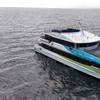The next MTS Houston Section luncheon will be held on April 28, 2011 and will feature a presentation by Carlos Ferraz Mastrangelo with Petrobras America. Mr. Mastrangelo will be discussing Petrobras’s decision to use a shuttle-tanker for its oil export system at the Cascade and Chinook developments.
While the combination of shuttle-tanker and FPSO is common in the North Sea, Brazil and other parts of the world, it is a first in the U.S. Gulf of Mexico. Despite the impressive pipeline infrastructure currently available in the U.S. Gulf, none of it reaches as far as the location of the Cascade and Chinook fields, at 160 miles south of the Louisiana coast, in the deep waters of the Walker Ridge quadrant. This prompted Petrobras to opt for a shuttle-tanker as its selected method for oil transportation.
Since the shuttle-tanker will be loading U.S. oil and transporting it to a U.S. terminal, the Merchant Marine Act of 1920 also known as the “Jones Act” applies. At our April 28 luncheon, Carlos Mastrangelo, Facilities Manager for Petrobras America, will discuss the strategy adopted by Petrobras. This strategy started with an innovative design competition, where Petrobras analyzed proposals of several types of vessels (ITB – Integrated Tub-Barge, ATB, Tanker-DP, and Conventional Tanker-Ship, new builds and conversions). Mr. Mastrangelo’s presentation will address how this design competition was controlled in order to ensure high safety levels and efficiency among the proposals evaluated. He will also address strategies adopted by Petrobras to enhance crew training, a major concern since there are no similar operations in the U.S. Gulf of Mexico.
Finally he will address the decision to operate the shuttle-tanker in Brazil prior to starting operations in the Gulf of Mexico. Shuttle-tankers are used all around the world. They are known as safe oil transportation alternatives and are supported by the industry and academic communities. Petrobras’s shuttle-tanker approach incorporates several safety features, meeting both Petrobras’s stringent safety procedures and the requirements of U.S. law.













